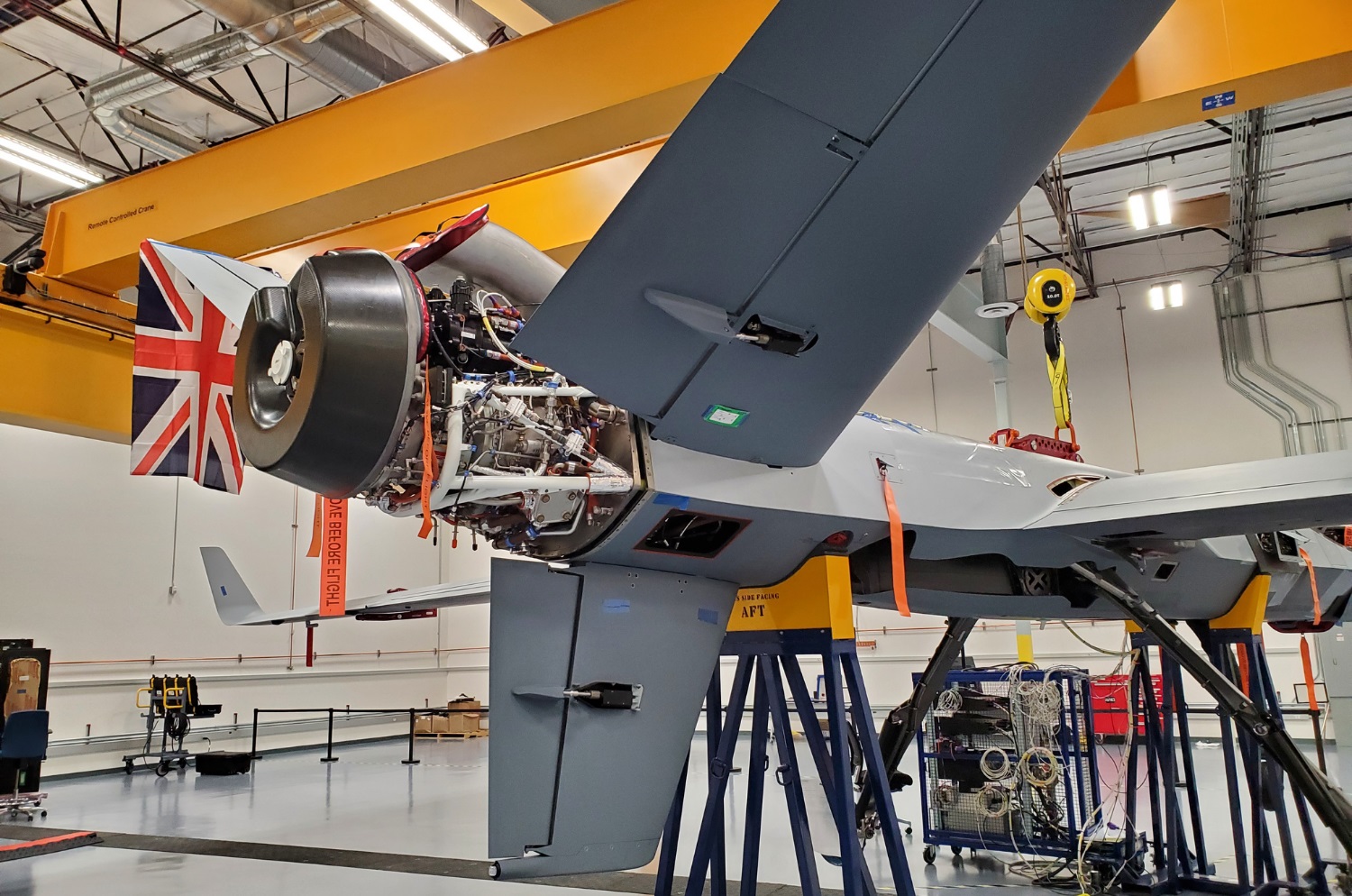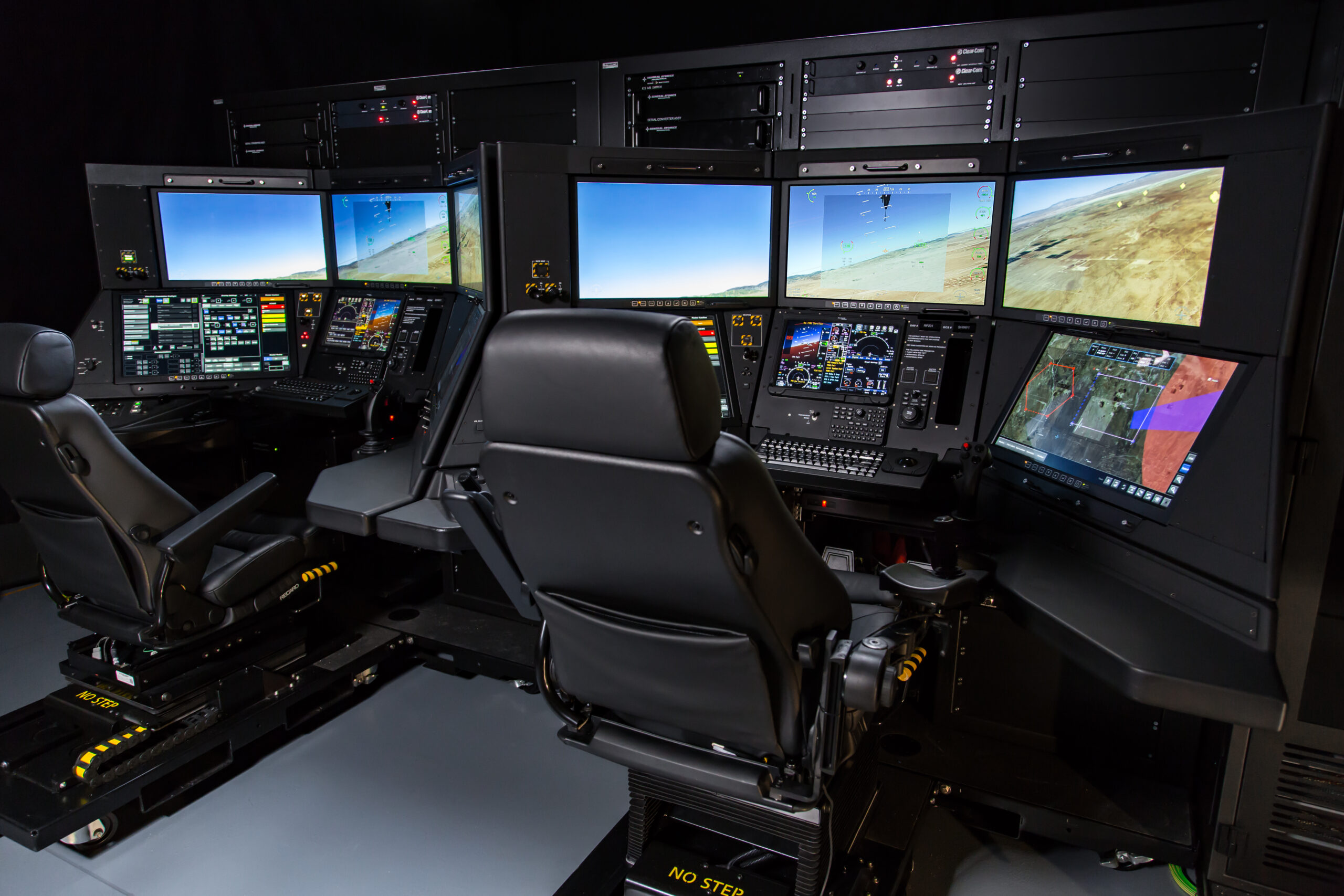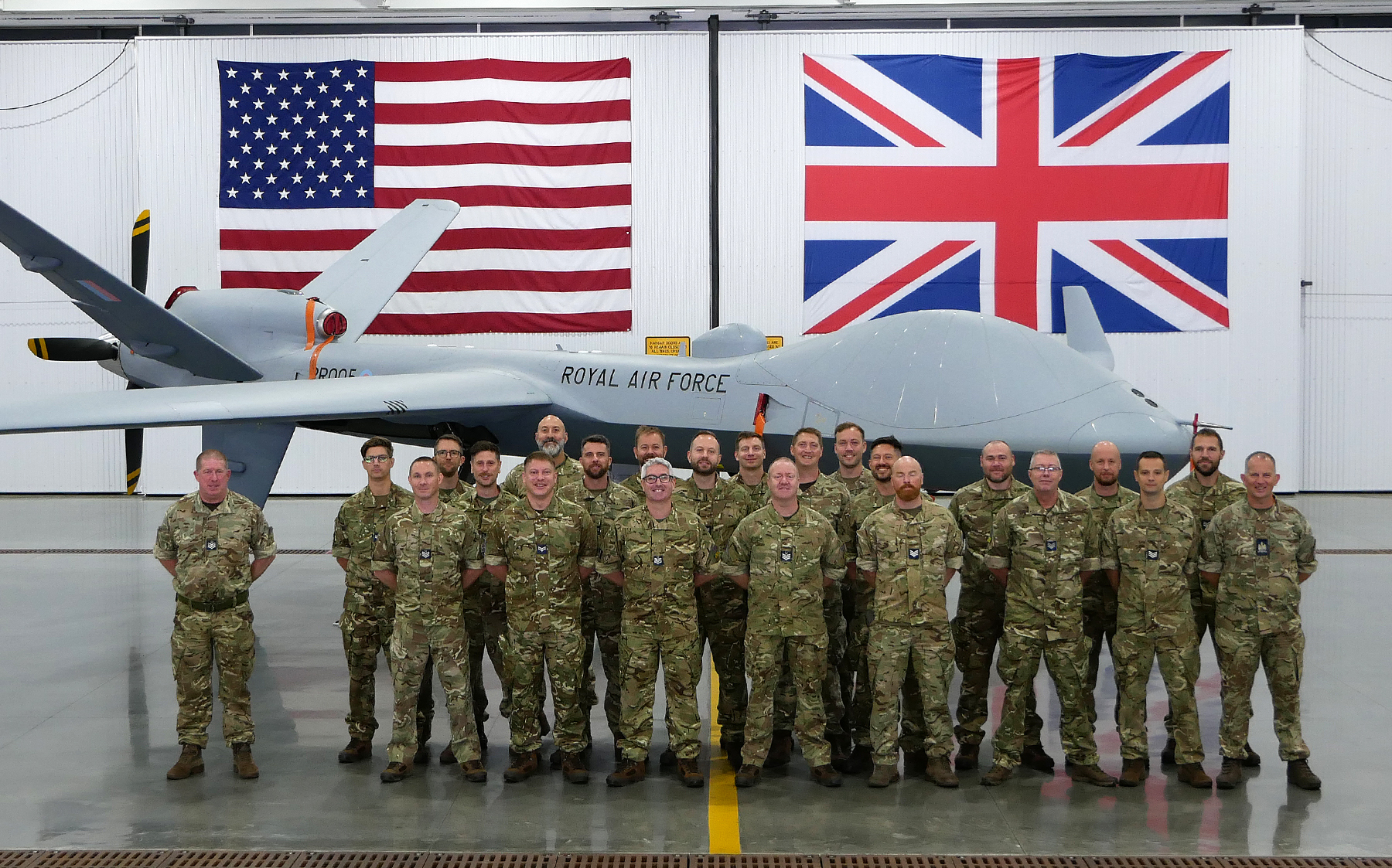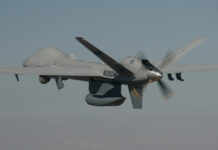The UK’s Royal Air Force accepted the first of 16 planned Protector RG Mk1 unmanned aerial vehicles (UAV) on 6 October 2022. The new long-endurance aircraft will offer a significant capability upgrade over previous UAVs and is expected to make a major contribution to securing the North Atlantic sea lanes and to global deployments.
The Protector RG Mk1 (or simply RG1) is a Medium-Altitude, Long-Endurance (MALE) UAV derived from the General Atomics Aeronautical Systems Inc. (GA-ASI) MQ-9B SkyGuardian/SeaGuardian, and is considered the next generation of MALE UAV technology.
The new aircraft was specifically configured to meet Britain’s operational requirements, and will replace the RAF’s MQ-9A Reapers, which are being retired. The Protector is expected to exceed the Reaper in all relevant attributes and performance parameters. The new UAVs will be stationed at and operate from RAF Waddington, current home of the MQ-9A. The air base, located in Lincolnshire in eastern England, will receive upgrades and infrastructure valued at GBP 94 M to accommodate the Protector.

Credit: GA-ASI
The ’RG’ portion of the RG Mk1 designator stands for reconnaissance/ground-attack, reflecting the Protector’s ability to conduct intelligence and surveillance missions, as well as engage surface targets on land or sea. The RG Mk1 is built in California by GA-ASI, with input from 12 UK firms. The British partners are contributing to every part of the aircraft system, from computer modules to engine development and logistical support. Particular notice has been paid to the V-tail assembly, which is being produced by GKN Aerospace on the Isle of Wight. In addition to the RAF’s Protectors, the GKN tail assembly will be utilised on all MQ-9B aircraft sold worldwide.
Mission Profile
“Protector represents a giant leap forward in technology and aircraft performance over its predecessor Reaper,” said Chief of the Air Staff Air Chief Marshal (ACM) Sir Mike Wigston in September 2021. “This aircraft will enable our government to act on a world stage within hours, at range, and precisely,” added Wigston, who retired in June 2023.
According to the RAF, the Protector will be deployed globally for wide-ranging intelligence, surveillance, target acquisition and reconnaissance (ISTAR) operations. ISTAR missions will include wide-area surveillance, as well as targeted reconnaissance missions. Operations will be conducted over land and over sea. The aircraft’s long endurance make it particularly suitable for patrol of strategic waterways such as the Greenland – Iceland – United Kingdom (GIUK) Gap. Recent advances in satellite communications (SATCOM) and high-performance datalinks will even permit Arctic patrols. GA-ASI demonstrated such capabilities in 2021 by deploying an MQ-9A UAV to the 78th parallel North, where the aircraft received communications support via Inmarsat’s L-band airborne ISR service. The capability for long-endurance missions over northern waters will support the UK’s intention to boost surveillance and data-gathering capabilities in the Arctic as defined in the MoD’s 2022 document ‘Defence Contribution in the High North’ as well as in the 2021 Defence Command Paper. The Protector will furthermore be well suited to augmenting the RAF’s P-8 Poseidon maritime patrol aircraft over the greater North Atlantic and other waters. Armed missions for the RG1 will include targeted attacks on static and moving targets (including targets of opportunity) on land and at sea, as well as close-air-support for ground forces. Humanitarian missions in support of civilian agencies’ disaster relief or search and rescue operations are also planned.
Technology and Capabilities Profile
The UAV is equipped with GA-ASI’s state-of-the-art detect-and-avoid technology, which employs radar and transponder data to safely fly alongside civilian aircraft in unsegregated and crowded airspace. This enables Protector to meet NATO and UK safety certification standards and become the first MALE UAV certified to operate in civilian airspace. This not only enhances safety but simplifies deployment as the operator merely needs to file a standard flight plan rather than reserve a special air corridor for transit flights.

Credit: RAF
The UAV has a length of 11.4 m, a wingspan of 24 m and a maximum take-off weight of 5,680 kg. The single Honeywell TPE331-10 turboprop engine enables a maximum altitude of 12,300 m and an airspeed of 108 m/s (210 kn). Like the Reaper, the Protector has an aft-mounted pusher-propellor. The new aircraft’s longer wingspan enhances range and payload capacity, and permits operations from shorter airfields. Mission endurance exceeds 40 hours, a significant improvement over the RAF’s Reapers, which can fly 20 hours unarmed or 12 hours with a full weapons load. The aircraft has advanced anti-icing and lightning protection features which permit operations in extreme weather conditions, as well as a fire-protected engine bay. The Protector’s maximum range exceeds 11,112 km (6,000 NM) and its damage-tolerant airframe is designed for a 40,000 flight-hour service life.
The aircraft is equipped with an X-band satellite communications system. Take-off and landing are conducted automatically. To enable this, the aircrew uploads GPS coordinates of the runway to the aircraft. The system then devises a navigation plan (in accordance with local air traffic control guidelines or airspace limitations) for the take-off or landing procedure. The aircraft will automatically abort a take-off run or landing approach if necessary; the Protector pilot can also assume control remotely at any time during the take-off or landing phase.
The UAV will be operated by a three-person crew consisting of two pilots and a weapon system/sensor operator. Aside from the take-off and landing phases, the Protector will be remotely controlled at all times. Pilots and systems operators will remain at RAF Waddington, regardless of the theatre of operations where the aircraft are deployed; only ground crews will deploy with the aircraft. This reduces the logistics footprint of the deployed unit, and permits operations to begin comparatively soon after arrival in theatre.
Payload Options
Payload capacity is 2,177 kg. The Protector’s standard integrated sensor suite includes a gimbal-mounted high-definition, large-aperture optoelectronic infrared (IR) video camera for long-range persistent day and night surveillance capability. GA-ASI’s proprietary Lynx synthetic aperture radar is permanently mounted inside the aircraft’s forward avionics payload bay. It can penetrate cloud cover, smoke, dust storms or blizzards to perform air-to-surface and air-to-air reconnaissance.
The airframe has nine hardpoints (eight underwing and one centreline) for external payloads. According to the British MoD, the RG Mk1 will carry a mixed load out, including MBDA’s Brimstone precision strike missile and Raytheon’s Paveway IV guided bombs on six of the underwing hardpoints. Each of these hardpoints can accommodate three Brimstone or one Paveway IV. The two outboard hardpoints are not intended for weapons, and can assume lighter loads.

Credit: UK MoD
The hull’s centreline can be used for additional sensor payloads as well as for defensive and offensive electronic warfare (EW) suites. One option is the Leonardo Seaspray 7500E V2 multimode maritime search radar (manufactured in Scotland). This Active Electronically Scanned Array (AESA) radar can observe large ocean swaths, tracking hundreds of large and small maritime contacts in high clutter environments. The Seaspray radar can also perform ground-mapping missions, conduct reconnaissance overland or monitor airspace via moving target detection; the latter capability enables deployment in an airborne early warning role.
Optional external EW payloads include the L3Harris Sledgehammer electronic attack pod, designed to deny enemy communication networks, disrupt command and control, and deliver information operations (Info Ops) messaging. The UAV can also be equipped with an internally carried Leonardo SAGE signals intelligence (SIGINT) suite capable of gathering intelligence on maritime and land-based radar emitters over a wide area.
Programme Milestones
The Protector programme was initiated in 2015. Selection of the MQ-9B airframe as the basis for the UAV was announced in April 2016. The initial development contact with GA-ASI announced in December 2016 was valued at GBP 100 M. In July 2020, the MoD and GA-ASI signed the formal procurement contract for the first three aircraft (plus three ground control stations and auxiliary equipment), with an option to acquire 13 more aircraft and an additional four control stations. The MoD exercised that option in July 2021, bringing the standing order to 16 aircraft. Both contracts together are valued at GBP 260 M.
Ground and air testing have progressed steadily. In July 2018, the first Protector prototype conducted a transatlantic flight from the US to the UK to participate in the Royal International Air Tattoo (RIAT) at RAF Fairford. The automated taxi, take-off and landing capability was demonstrated in 2019. In July 2021, the Protector prototype returned to RAF Waddington for airspace integration flights and to conduct capability demonstrations before participating in the multinational Joint Warrior exercise in Scotland. The aircraft returned to the US in September 2021. All of these prototype demonstrations were conducted by GA-ASI personnel.

Credit: UK MoD
The UK’s first operational Protector aircraft conducted its maiden flight in September 2020. The Acceptance Test Procedure (ATP) was completed on 26 August 2022 following a two-month series of inspections and tests conducted at GA-ASI’s Desert Horizon flight operations facility in El Mirage, California. The two-hour culmination flight was jointly conducted by UK MoD personnel and GA-ASI employees. In addition to the aircraft, the evaluation also included vital ground equipment designated as ‘Portable Pre-flight and Post-flight Equipment’, or P3E. According to a FA-ASI press release, P3E is laptop-sized piece of ground support equipment that enables SATCOM automatic taxi, take-off and landing capability from anywhere in the world, allowing a small personnel and equipment footprint during deployments. The P3E doubles as ground support equipment when directly connected to the aircraft.
Successful completion of the ATP paved the way for the official handover of the first operational aircraft to the RAF on 7 September 2022, receiving the RAF tail number PR005. For the time being, it has remained in the US to support aircrew training, but is due to be transferred to its operational home at RAF Waddington later in 2023.

Credit: UK MoD
Crew Training
The first Protector ground crews graduated from training on 1 March 2023 at the GA-ASI facility in El Mirage. The initial training phase consisted of a blend of classroom-based theory and practical assessment, and was conducted from October through December 2022. It was followed by a six-week period which included live operation of the air system. The 20 engineering personnel of the first cohort successfully qualified as dedicated cross-skilled technicians. The individual personnel combine skills as avionics technician, mechanical technician and ordnance technician. Cross-qualification of personnel will be particularly valuable overseas, where small engineering detachments will be responsible for maintaining and preparing the aircraft between flights.
Training of the first Protector flight crews began on 1 May 2023, conducted by the RAF’s 54 Sqn at GA-ASI’s Flight Test & Training Center (FTTC) in Grand Forks, North Dakota. The first cohort includes eight complete crews consisting of pilots, sensor operators (SOs) and mission intelligence coordinators (MICs). The curriculum for pilots and sensor operators runs for 12 weeks; mission intelligence coordinators complete their portion of the programme after six weeks. The programme includes both simulator and live flying sessions. As reported in May 2023 by ESD’s Peter Falstead, the scope of the training is focused on the foundational skills required to operate the Protector and its equipment, including its multi-spectral targeting system, synthetic aperture radar, mission intelligence station, and system for tasking and real-time exploitation (STARE). Training involves building solid foundations for both normal and emergency operations in ISR systems, instrument flying, and automatic take-off and landing. The mission intelligence coordinators train on the system’s mission intelligence station, learning to conduct real-time exploitation of intelligence gathered by the aircraft’s multi-spectral targeting system and synthetic aperture radar. After the first group of pilots, SOs and MICs graduates, GA-ASI will train another three cohorts, each consisting of eight complete crews. The RAF will assume the training of aircrews and technicians once the Protector International Training Centre opens at RAF Waddington in 2024.

Credit: GA-ASI
Preparing for Service
The RAF’s 31 Sqn, a former Tornado GR4 squadron deactivated in 2019, will formally reconstitute in October 2023 to become the first Protector RG Mk1 operational unit. A cadre of personnel has been preparing the transition. Standing up the squadron will mark the Protector’s official service debut with the RAF, but considerable training and integration work will still be required. The GR Mk 1 is scheduled to achieve Initial Operating Capability (IOC) in 2024. Full Operating Capability (FOC) is expected in 2026. To earn that designation the RAF must be capable of conducting three separate missions simultaneously, each with 24/7 coverage.
In addition to 31 Sqn, the UAVs will also be operated by 13 Sqn (which currently operates the MQ-9A Reaper). Both units are subordinate to the RAF’s No. 1 ISR Wing which was established in May 2021 at RAF Waddington. The wing also includes squadrons operating the RC-135W Rivet Joint and Shadow R1 fixed-wing ISR aircraft. Other units of No. 1 ISR Wing include 1 ISR Sqn which analyses video obtained by the Protector (and other ISR aircraft), as well as 54 Sqn (the conversion unit responsible for personnel training on airborne ISTAR systems).

Credit: RAF
As ACM Wigston pointed out in 2021, the Protector will be a fully UK-owned sovereign capability, in contrast to the Reaper drones which were operated by the RAF but which (as the former Chief of Air Staff stated) were an urgent operational requirement for Afghanistan that was largely controlled by the US. Other nations are interested in acquiring the Protector variant of the MQ-9B. The UK will act as the lead nation for training and integration support, utilising the Protector International Training Centre at RAF Waddington to support partner nations acquiring the RG Mk1. Belgium has already contracted to procure four Protectors, with Brussels and London signing a statement of intent to cooperate on agreement in August 2020 covering collaboration in training, maintenance, logistics support, and interoperability. This was followed up by the two sides signing a memorandum of understanding in April 2023, allowing the two countries to work together on all programme areas, including certification, airworthiness, training, sustainment, and future capability enhancements.
Sidney E. Dean





